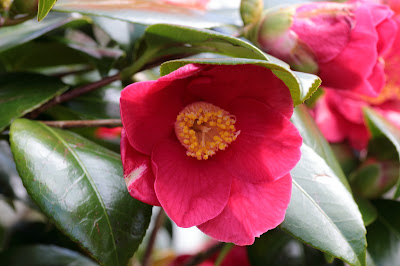It's been a long winter in the UK, even in the far South West. Temperatures are starting to pick up now but we've had weeks and weeks of cold, easterly winds and barely above freezing weather. No snow down here but everything in the garden has been very reluctant to show any development since the last Garden Blogger's Bloom Day I contributed to back in February. Fortunately the last week or so has seen things improve and I do have some colour and interest at long last.
Stars of the show are the camellias. And star of the camellia show has to be
Camellia x williamsii 'Donation'. The bush in the front garden is now fairly substantial - about 7ft / 2.2metres high and wide - and smothered in big, 5-6in / 15cm semi double blooms. A gorgeous sight and I make no apologies for including multiple photos. As always, click the photos to embiggen.
 |
| Camellia x williamsii 'Donation' |
 |
| Camellia x williamsii 'Donation' |
 |
| Camellia x williamsii 'Donation' |
 |
| Camellia x williamsii 'Donation' |
My other spring flowering camellias are also in bloom, albeit that 'Cornish Snow' only has a few buds left to open and 'Anticipation' has barely got started. The mis-sold small pink semi double that I've very tentatively identified as 'Magnoliiflora' is flowering away but it's never been as densely covered as 'Donation' or the specimen of 'St Ewe' in the front garden. Welcome, nevertheless.
 |
| Unidentified small pink Camellia - possibly 'Magnoliiflora' |
 |
| Camellia x williamsii 'St Ewe' |
Covering the ground are a lot of seed set primroses, both the wild type and their hybridised offspring. Over the years I've added the odd decorative type; singles, doubles and polyanthus types. They haven't persisted - but they've left their legacy and broadened the gene pool of the more persistent natives. So I can go from perfect wild types like this:
 |
| Primula vulgaris - wild type primrose |
To shades of cream, pale and darker pink to red.
 |
| Primula vulgaris - a redder flowered variant |
I really should add some more variants to refresh the range.
Speaking of plants that persist from year to year and spread mildly by seeding I regularly get a crop of the intensely blue flowered
Myosotis despite not having sown any for years. These do bear very close inspection to appreciate the true beauty of the intensely blue but tiny flowers. You get the same effect with
Brunnera macrophylla but that's been very late to emerge this year so won't feature in this blog entry.
 |
| Myosotis |
Another persistent seeder is
Viola labradorica, one I introduced years ago for its darker leaves and pretty little flowers. Even if I wanted to I doubt I'd ever be able to get rid of it. The soil must be saturated with seed by now.
 |
| Viola labradorica |
Lesser celandine,
Ranunculus ficaria, is a pretty little yellow buttercup that crops up in the garden, usually spread by disturbing the little white tubers during cultivation. It's not a problem and its pretty enough at this time of year. Over the years a host of variants have been found in the wild and, increasingly, in gardens. Singles, doubles, with a colour range from white through yellow to orange and varieties with marbled and bronzed leaves. One that's very persistent and true to type with me is 'Brazen Hussy', with chocolate brown leaves and bright yellow flowers. I've got quite a nice carpet of this in the rear garden and it's increasing year by year.
 |
| Ranunculus ficaria 'Brazen Hussy' |
Now the caveat. My plant certainly matches the description of 'Brazen Hussy', first found in the wild by great plantsman and author Christopher Lloyd near his fabulous Great Dixter garden. It's common in cultivation - but I didn't buy it or acquire it as a pass on. My plant also came from the wild, so either it's a very similar chance variant or, more likely I've collected one of the offspring of a plant that a local resident has thrown out or deliberately planted to beautify the surrounding countryside.
That's about it for this month. The early bulbs did make an appearance but are now faded. The later bulbs - tulips, spanish bluebell, erythronium and others are very late this year. Herbaceous plants such as pulmonarias and epimediums are still shivering with cold and rather reluctant to poke their heads above ground let alone flower. My blossom trees, Magnolia 'Raspberry Ice' and Prunus 'Amanogawa', should both be in full flower but are both waiting for a bit more warmth. But at least
Pieris 'Flaming Silver' is starting to flower more regularly and prolifically as it gets older and bigger. So that's the note I'll leave you on.
 |
| Pieris 'Flaming Silver' flowers |
As always, my thanks to
May Dreams Gardens
for hosting the Garden Bloggers' Bloom Day meme. Head over there to
see what's flowering in many more gardens round the world.














































